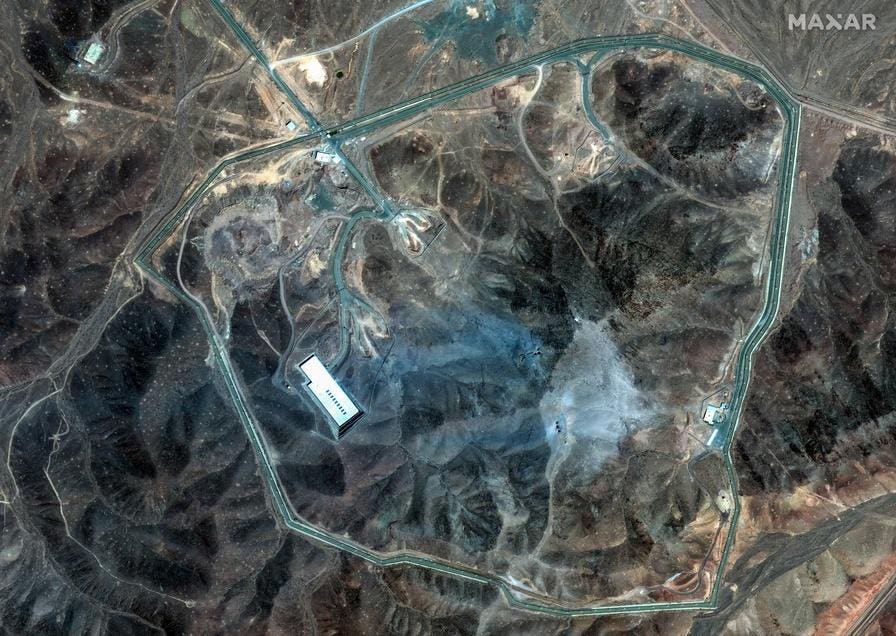Satellite Imagery of Fordow complex gives only limited indication of damage
President Trump declared Operation Midnight Hammer to destroy Iranian nuclear sites “a spectacular military success” before the B-2 bombers had even returned. The mission dropped 14 giant GBU-57 Massive Ordnance Penetrators on three sites.
“Iran’s key nuclear enrichment facilities have been completely and totally obliterated,” Trump added.
General Dan Caine, Chairman of the Joint Chiefs of Staff , was more measured, noting that “Final battle damage will take some time” but that the Air Force assessed that “all three sites sustained extremely severe damage.”
Given that the three sites are buried deep underground and as expected there is little to see on the surface – no huge explosions or columns of smoke, no destroyed buildings – so what can we actually tell?
Palpable Hits
Satellite images of Fordow after the strike show little visible damage, just two groups of three holes in the ground. And that looks like excellent bombing by the USAF.
Orange circles show two groups of three small holes left by U.S. bombs
Each B-2 bomber carried two bombs, and a total of 14 were dropped, 6 on Fordow. Evidently there were two aim points, and each was assigned a bomb, a backup in case the first failed, and a second backup to make sure.
There are good reasons for having redundancy. In May and June 2013, two test drops of the Massive Ordnance Penetrator failed. According to a report by the Air Force’s Director Operational Test and Evaluation, in one case the bombing was aborted due to a badly-soldered connector. In the other a faulty connector prevented the bomb being released. When every bomb is vital, backups are essential.
The close grouping also shows that the MOPs GPS-guidance systems worked as intended. In Ukraine, U.S.-supplied satellite guided smart bombs frequently miss their targets by a wide margin due to jamming. The MOPs is supposedly jam-resistant, but the arms race of jamming and counter-jamming mean that constant upgrades are needed and success is far from certain. In this case there seem to have been six bullseyes out of six.
Underground Mysteries
The holes on the surface give a good idea of how MOP works: rather than leaving a crater on the surface, it hits the ground at high speed and punches through soil, rock and concrete before exploding far underground. Those holes may not be much larger than the 32-inch diameter of the bomb.
An earlier generation bunker buster, the Tallboy 22, 000-bomb used by the RAF in WWII could break … More
Some WWII Tallboy bunker busters were dropped from such high altitude that they actually broke the speed of sound as they fell. This phenomenal speed ensures the bomb reaches as far underground as possible. We do not know the release altitude, but MOPs were designed with a similar attack profile in mind.
Once underground the bunker-buster continues on its path, and the MOP can reportedly penetrate two hundred feet or more. However, rock and concrete offer far more resistance than air, and the tremendous friction involved causes high-speed erosion of the bomb casing. The MOP is made from a special alloy known as Eglin Steel, developed by the Air Force for bunker busters and other demanding applications, but even this is worn down. If there is any unevenness in wear the bomb will slew to one side and curve away from a straight path. In one test of a high-velocity projectiles against concrete blocks, uneven wear caused a ‘J-Hook’ path, and the projectile came out the same side it was fired into.
The nose of the MOP is specially designed to ensure a straight path through solid rock, and the Air Force say it has been successful in tests. We assume that conditions were similar to Fordow but success is not automatic.
Assuming the MOPs travelled straight and true, the next question is whether they exploded in the right place. Fusing for bunker busters is extremely challenging. If a facility is located sixty feet below the ground, the weapon needs to explode in that open space – not in solid rock twenty feet above or below the facility.
Early bunker busters relied on time-delay fuses and a rough estimate of how long it would take to reach a given depth, assuming the depth of the target was known.
The Air Force’s Wright Laboratory developed a much more sophisticated alternative, the Hard-Target Smart Fuze (HTSF). This is fitted with accelerometers and can be set to explode either at a certain distance, or when it encounters a ‘void’ and open space in the solid material it is burrowing through.
However, the problem with the HTSF, as I wrote back in 2007, was that it did not work, or, as the Air Force, said it “experienced Engineering and Manufacturing Development qualification problems resulting in termination of the program.” Anecdotal reports suggest the fuse did not survive the shock of impact when the bomb hit solid rock.
The Air Force hastily located an alternative, the German-made Programmable Intelligent Multi-Purpose Fuze (PIMPF) used in the Taurus missile. This was integrated into U.S. weapons under the euphemistic Void Sensing Fuze (VSF) Product Improvement Program.
The Hard Target Void Sensing Fuse can go through several levels before exploding at a pre-determined … More
According to David Fine, then vice president of fusing and warheads for Orbital ATK Defense Systems, speaking to National Defense magazine in 2018, the new version is extremely robust to impact and its void-sensing capability means it does not just detect underground spaces but counts as it passes through them.
“You might just have a deeply buried facility protected by earth and concrete,” Fine said. “You might have a multi-layered target … [such as] a complex facility buried underground that has 10 stories, and you might decide the critical mission space is in the fifth story. So the fuze can be programmed to detect when it reaches the fifth story.”
Again, we do not know whether the fuses operated correctly and whether the warheads detonated at the correct level.
Signs of possible subsidence on satellite images likely indicate that some underground spaces collapsed. Interestingly though, Israel has apparently carried out airstrikes on Fordow since the U.S. attack.
The Question Of Intelligence
Naturally, the entire mission depended crucially on intelligence, and knowing the exact layout of the underground facilities. The facilities below may be hundreds or thousands of feet away from the tunnel entrances at the surface. And the location within the facility of the crucial elements such as centrifuges is crucial to ensure they are hit and destroyed.
Clearly the USAF was confident of its intelligence on the targets, and Iranian security appears to be very weak. But there is also the more serious question of what was actually struck.
As Dr Jeffrey Lewis, founder of Arms Control Wonk notes on a thread on Twitter/X , images show a number of trucks at Fordow the day before the strike, “possibly to relocate sensitive equipment.”
Lewis also notes that Iran recently announced a new uranium enrichment facility at a secret location and had invited the International Atomic Agency inspectors to look at it.
“Iran said it had a new enrichment facility. The @iaeaorg was about to go see it. But before that could happen, Israel struck other facilities in Iran — but not the new one. See the problem?” says Lewis.
Uranium enrichment in Germany. Iran may still have a number of active centrifuges in secret … More
Damage assessment via satellite and other sensos, and intelligence from agents and signal intercepts in Iran, will confirm just how much of Iran’s nuclear program really was destroyed by Midnight Hammer.
There is no doubt that the strike will be recorded as one of the most successful strategic bombing operations in history. It achieved total surprise, put all its bombs precisely on the targets identified after flying thousands and miles and all planes returned safely home with no casualties.
But it seems too early yet to say whether this military brilliance succeeded in achieving its objectives.









